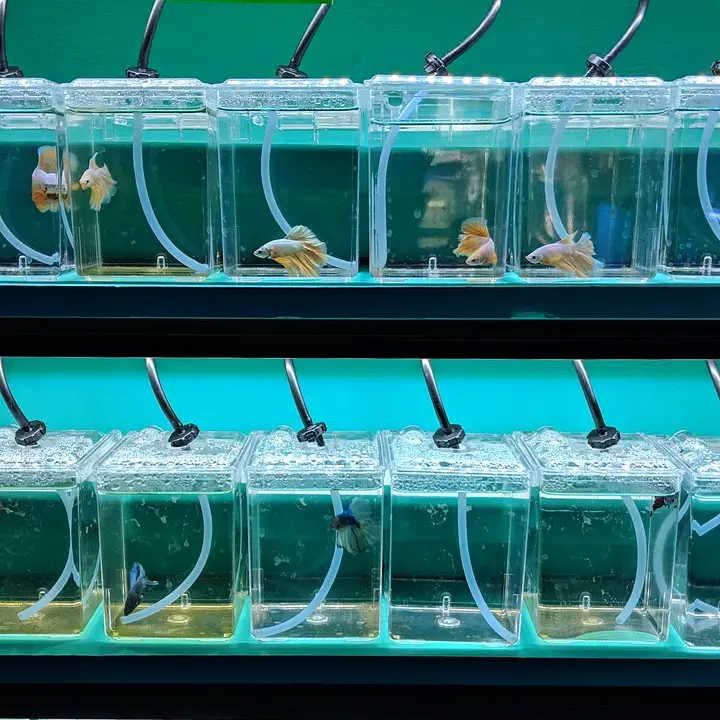Betta fish are one of the most popular fish in the world. Their vibrant colors and long flowing fins have made them a favorite of many aquarium enthusiasts. However, breeding Betta fish can be a daunting task. One way to simplify the process is to set up a Betta fish rack for breeding.
A Betta fish rack can make breeding Betta fish easier and more efficient. With multiple tanks stacked on top of each other, a Betta fish rack allows for more fish to be bred in a smaller space. In this article, we will discuss the benefits of setting up a Betta fish rack for breeding and provide step-by-step instructions on how to do so.
To set up a Betta fish rack for breeding, you will need a sturdy metal or wooden frame with shelves. Each shelf should have a separate container or aquarium for each Betta fish pair. The containers should be equipped with heaters, filters, and hiding places. The water quality should be maintained with regular water changes and testing. Lighting should be kept to a minimum and a consistent temperature should be maintained. A Betta fish rack provides a space-efficient solution for breeding Betta fish.

Setting Up a Betta Fish Rack for Breeding: A Comprehensive Guide
Betta fish, also known as Siamese fighting fish, are a popular choice among fish enthusiasts. They are not only beautiful and colorful, but also relatively easy to care for. If you are interested in breeding betta fish, setting up a betta fish rack is an efficient and practical way to breed multiple fish at once. In this article, we will provide you with a step-by-step guide on how to set up a betta fish rack for breeding.
1. Choosing the Right Rack
The first step in setting up a betta fish rack is to choose the right rack. A sturdy metal rack with adjustable shelves is recommended, as it allows you to customize the spacing between shelves according to the size of your breeding containers. Make sure the rack is tall enough to accommodate your breeding containers, with enough clearance between shelves for easy access.
Once you have found the right rack, measure the dimensions of the shelves and determine the number of containers you can fit on each shelf. This will help you determine the number of betta fish you can breed at once.
2. Selecting the Breeding Containers
The next step is to select the breeding containers. Clear plastic shoebox containers with lids are a popular choice among betta fish breeders, as they are affordable, easy to clean, and provide enough space for the fish to swim and breed. Make sure the containers are large enough to accommodate a male and female betta fish, with enough space for them to build a bubble nest.
3. Setting Up the Containers
Once you have selected the breeding containers, it’s time to set them up. Fill each container with dechlorinated water and add a heater to maintain a consistent temperature of around 78 degrees Fahrenheit. Install a sponge filter to create a gentle current and provide oxygen for the fish. You can also add live plants and a hiding spot for the female betta fish.
4. Conditioning the Breeding Pair
Before introducing the betta fish to the breeding containers, it’s important to condition them. Feed them a high-protein diet, such as frozen or live brine shrimp, to stimulate breeding behavior. Keep the male and female betta fish in separate containers, but within sight of each other, for a few days to allow them to get used to each other’s presence.
5. Introducing the Breeding Pair
Once the betta fish are fully conditioned, it’s time to introduce them to the breeding containers. Place the female betta fish in her container first, followed by the male betta fish a few hours later. The male betta fish will start building a bubble nest, which is a sign that he is ready to breed.
6. Monitoring the Breeding
After introducing the breeding pair, it’s important to monitor them closely to ensure successful breeding. The male betta fish will wrap his body around the female betta fish and release sperm into the water. The female betta fish will then pick up the eggs and deposit them into the bubble nest. Remove the female betta fish once breeding is complete, as the male betta fish will guard the eggs and protect the fry.
7. Hatching the Eggs
The eggs will hatch in 24-48 hours, depending on the temperature of the water. Once the fry hatch, remove the male betta fish and transfer the fry to a separate container with clean, dechlorinated water. Feed them a high-protein diet, such as newly hatched brine shrimp or finely crushed flakes, several times a day.
8. Growing Out the Fry
As the fry grow, they will need to be transferred to larger containers to accommodate their growing size. Monitor the water parameters closely and perform regular water changes to maintain good water quality. Gradually introduce them to a varied diet of live and frozen foods.
9. Benefits of Using a Betta Fish Rack for Breeding
Using a betta fish rack for breeding offers several benefits, such as saving space, time, and effort. Breeding multiple betta fish at once allows you to produce a larger number of high-quality fish for sale or personal collection. It also allows you to easily monitor and maintain the water parameters of each container.
10. Betta Fish Rack vs. Individual Breeding Containers
While individual breeding containers can be effective for breeding betta fish, using a betta fish rack offers several advantages. It saves space and allows you to breed multiple fish at once, making it a more efficient and practical option. It also allows you to easily monitor and maintain the water quality of each container, reducing the risk of disease and other issues.
Freequently Asked Questions
In this section, we will be discussing the frequently asked questions about setting up a betta fish rack for breeding. If you are planning to start breeding betta fish, then you need to know the basics of setting up a betta fish rack. It is essential to know the proper way of setting up a betta fish rack to provide the best environment for breeding.
What is a Betta Fish Rack?
A betta fish rack is a series of interconnected tanks that are used to breed and house betta fish. The tanks are usually made of plastic and are stacked on top of each other to save space. Betta fish racks are an excellent way to breed betta fish in a controlled environment.
The rack should be positioned in a place where it is easy to clean and maintain. You should also make sure that the rack is placed in an area where there is a stable water supply and temperature. Once you have found the perfect spot for your betta fish rack, you can start setting it up.
How to Set Up a Betta Fish Rack?
Before you start setting up your betta fish rack, you need to make sure that you have all the necessary equipment. You will need tanks, heaters, filters, and air pumps. You will also need plastic dividers to separate each tank and prevent the betta fish from fighting with each other.
Once you have all the necessary equipment, you can start setting up the rack. Start by assembling the rack and placing the tanks on the shelves. Install the heaters and filters, and connect the air pumps. Then, fill the tanks with water, and add the plastic dividers to separate the betta fish. Once everything is set up, you can add the betta fish to the tanks.
What is the Best Water Temperature for Breeding Betta Fish?
The best water temperature for breeding betta fish is between 78°F and 82°F. You can use a heater to maintain the water temperature in the tanks. It is essential to keep the water temperature stable to prevent stress on the betta fish, which can lead to illness and death.
You should also make sure that the water is clean and free from harmful chemicals. You can use a water conditioner to remove chlorine and other harmful chemicals from the water. It is also recommended to change the water in the tanks regularly to keep the water clean and healthy for the betta fish.
How to Feed Betta Fish in a Rack?
Feeding betta fish in a rack is easy. You can feed them twice a day using betta fish pellets or flakes. It is important not to overfeed the betta fish as this can lead to health problems. You should also make sure that the food is small enough for the betta fish to eat.
It is also recommended to vary the diet of the betta fish by feeding them live or frozen food such as bloodworms or brine shrimp. This will provide the betta fish with a more balanced diet and help them stay healthy.
How to Maintain a Betta Fish Rack?
Maintaining a betta fish rack is essential to keep the betta fish healthy and happy. You should regularly clean the tanks and change the water to keep it clean and free from harmful chemicals. You should also check the equipment such as heaters, filters, and air pumps to make sure they are working correctly.
If you notice any problems with the betta fish such as illness or aggression, you should separate the affected fish and treat them accordingly. It is also important to monitor the water temperature and quality regularly to prevent any problems from occurring.
Betta Breeding Tank Rack – Air System Setup (step by step)
In conclusion, setting up a betta fish rack for breeding can be a rewarding experience for fish enthusiasts. With the right equipment, knowledge, and dedication, breeders can create a safe and healthy environment for their fish to thrive and reproduce.
By following the proper steps for selecting and conditioning breeding pairs, monitoring water quality and parameters, and providing ample space and hiding places for fry, breeders can increase their chances of successful breeding.
Overall, if you are passionate about betta fish breeding and have the time and resources to commit to this hobby, setting up a betta fish rack can be a fulfilling and enjoyable endeavor. With patience and perseverance, breeders can create a beautiful and thriving community of betta fish in their own home.
